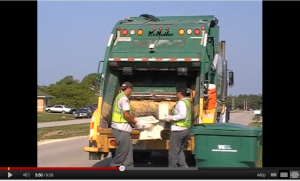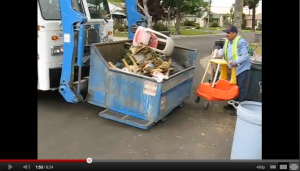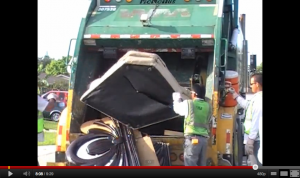 I live in a bubble. Its name is San Francisco, a magical place where everyone recycles, no one smokes, and Nancy Pelosi is considered distressingly conservative. Worse, I teach environmental sustainability at Stanford, where I’m surrounded by bicycle riding, reusable mug toting, enthusiastically composting colleagues and students. I come from the outside world, so I know my current behavioral baseline is a little skewed. But still, I was recently reminded that some Americans continue to use incandescent light bulbs, and I was genuinely surprised.
I live in a bubble. Its name is San Francisco, a magical place where everyone recycles, no one smokes, and Nancy Pelosi is considered distressingly conservative. Worse, I teach environmental sustainability at Stanford, where I’m surrounded by bicycle riding, reusable mug toting, enthusiastically composting colleagues and students. I come from the outside world, so I know my current behavioral baseline is a little skewed. But still, I was recently reminded that some Americans continue to use incandescent light bulbs, and I was genuinely surprised.
A far bigger shock came, as they usually do, unbidden from the Internet. At home, “garbage truck!” was among my son’s first phrases. The kid loves everything to do with tossing items into cans, wheeling them to the curb, and best of all, waiting for the awesome machines that come once a week to grab and hydraulically dump! dump! dump! the rolling containers for recyclables, compostables and landfill-destined trash into their hungry mechanical maws.
In between garbage days, we sometimes watch garbage truck videos on YouTube. (Not every day, and with full parental participation—c’mon bubble people, a *little* screen time isn’t going to hurt him.) If you don’t have young children, you might not be aware that the garbage truck video is a robust genre. Home-shot compilations with titles like “Garbage Trucks Part II” and “Types of ‘Garbage Truck’” amass millions of views, mostly, presumably, by delighted youngsters. They see everything from traditional rear-loaders, to automated side- and front-loaders, to the exotic knuckle boom trucks, which look like those arcade games where you try to grab a stuffed doll by the head with a set of metal claws.
 And here’s what else the kids see: that every last manifestation of the American dream of disposable consumption can be hauled to the curb and disappeared into the crushing jaws of a garbage truck by municipal workers in fluorescent green safety vests. Some households astound by sheer volume—8, 10 or 12 black garbage bags per pickup elicit nary a comment nor complaint from the workers. But it’s the exotic items that really surprise. Is the home basketball hoop a little banged up? Toss it in! Have a five-piece living room set that clashes with the new drapes? Grind it up! An unwanted toilet? In it goes!
And here’s what else the kids see: that every last manifestation of the American dream of disposable consumption can be hauled to the curb and disappeared into the crushing jaws of a garbage truck by municipal workers in fluorescent green safety vests. Some households astound by sheer volume—8, 10 or 12 black garbage bags per pickup elicit nary a comment nor complaint from the workers. But it’s the exotic items that really surprise. Is the home basketball hoop a little banged up? Toss it in! Have a five-piece living room set that clashes with the new drapes? Grind it up! An unwanted toilet? In it goes!
Here in the bubble, recycling and composting are the law for households and businesses alike. My students go out of their way to build side tables out of old VHS cassettes, and kinetic pelican sculptures out of scavenged bleach bottles and PVC pipe, for gosh sakes. Overall, the daily generation of landfill-destined trash in the US has declined modestly since a 2000 high of nearly 4 ¾ pounds per person. But the ethnographic evidence of YouTube does not lie: Americans still throw out an absurd amount and variety of stuff, most of it either sellable, salvageable, or recyclable.
 In one particularly heartbreaking YouTube moment, senseless violence is committed against what appears to be an entire toddler-hood worth of toys. I usually enjoy the garbage videos almost as much as my son does, but seeing two perfectly good toy cars—the Flintstonesque foot-powered ones kids ride in—pitched into a formidable McNeilus front-end loader is too much. It’s like watching a disposable consumption snuff film. I paid $20 for one much like them on craigslist last year, and would happily have offered $35 for the pair. But I’m just one guy, darn it, I can’t save them all.
In one particularly heartbreaking YouTube moment, senseless violence is committed against what appears to be an entire toddler-hood worth of toys. I usually enjoy the garbage videos almost as much as my son does, but seeing two perfectly good toy cars—the Flintstonesque foot-powered ones kids ride in—pitched into a formidable McNeilus front-end loader is too much. It’s like watching a disposable consumption snuff film. I paid $20 for one much like them on craigslist last year, and would happily have offered $35 for the pair. But I’m just one guy, darn it, I can’t save them all.
Doing something decent with your castoffs has never been easier. Recycling databases at websites like earth911.com and 1800recycling.com make it simple to find local recyclers for even the most exotic goods. Building material salvagers are on the rise; craigslist and freecycle make it a snap to sell or donate just about anything that can still be used. And of course, you can always just buy less crap.
But when it comes to waste management decisions, nothing is easier than the curb. That’s what makes curbside recycling and composting programs so successful, especially single stream recycling, which doesn’t require rinsing or sorting of recyclables. But it’s also what makes hauling perfectly good stuff out to the sidewalk seem reasonable to so many people.
I’m no garbage wimp, by the way, effetely bemoaning the excesses of others. As a youngster, I spent a couple of summers intermittently driving a garbage truck in a small community in northern Saskatchewan. But here’s the real heartbreak—my time behind the wheel of a rear-loader happened long before the advent of digital cameras, and no video was ever taken. If only I had 3 or 4 minutes of that sweet garbage action recorded, I swear I could give “Types of ‘Garbage Truck’ II” a run for its money.
Images Screen grabs, from top to bottom: “McNeilus Tag Axle Rear Loader” by georgewuzheer (first three images), “I spent some time on Orange County today” by shadofax96 (the toys–look away) and “Types of ‘Garbage Truck’” by FormerWMDriver. Dump! Dump! Dump!


It’s nice to think we should recycle and reuse more, and we should but really it boils down to the fact that we (the consumer) buy too much crap to begin with.
Hi @Magoonski. I agree: crap in = crap out, in one form or another!
This is my garbage (and data-collecting) hero, someone I included in a New Scientist feature about packaging in 2007:
“After my failed attempt to go packaging-free, I got in touch with Reuben Deumling, a graduate student in the Energy and Resources group at the University of California, Berkeley. Deumling and his wife, who now live in Portland, Oregon, weighed and recorded every item that entered and left the house for more than a year. In 2002, they together consumed about 2.5 kilograms of food per day—encompassing nearly 180 different food products over the year. By recycling and composting what they could, they limited the amount sent to landfill over the year to just 4.7 kilograms each. Compare that to the average American, who generates around 0.7 kilograms per day, topping Deumling’s annual total in a week… He throws so little away that he has no need for a kerbside garbage service.”
I think he has at least one child now, so I wonder whether he now subscribes to a curbside garbage service… whether on account of increased trash generation, or for the joy of truck watching.
Magoonski is certainly correct.
I’m trying to make it easier for people to be aware of options beyond the garbage, over at Waste Nothing http://wastenothing.ca/ . There are lots of great ideas and organizations, but it can be hard to track them down, so Waste Nothing is an attempt to bring it all to one place.
got to mention my favorite quote (unknown source): A man’s wealth is measured not in how much he has, but how little he needs. Great post – thanks!
I was born in the fifties when the trash bag for a house of six was a paper grocery sack stuffed into an 8×12 inch wooden box that was concealed behind a cupboard door next to the dishwasher. Milk and soda came in glass, and styrofoam hadn’t been invented yet (at least not for public use) so our meat came in a pressed paper tray or butcher paper. As a child of grade school age, I worried terribly about the amount of garbage we stuffed into the trash, which was minimal by today’s standards. We loved the neighborhood “garbagemen” (and milkmen too) who would sometimes give us rides in their trucks!
You could build a house out of what people throw away.
Actually, if you live in Baltimore, you literally could: there’s a place called The Loading Dock that basically goes dumpster diving for the kind of almost-new stuff people love to throw away: furniture sets, entire kitchen cabinet sets, beautiful old sinks, toilets, wood floors, pipes — and about 1000 other kinds of stuff. It’s like a second hand home depot in there. And it is epically cheap.
That place is heaven if you’re trying to redo a house on the super cheap.
http://loadingdock.org/
If you really want to have fun with trash machines, check out the garbage truck dance (truly) performed in Austin. You never would have guessed a crane could be so beguiling. (We missed out on the performance in this video but were in attendance at the encore over the summer.)
http://vimeo.com/10093886
and
http://www.forkliftdanceworks.org/projects/trash_project/